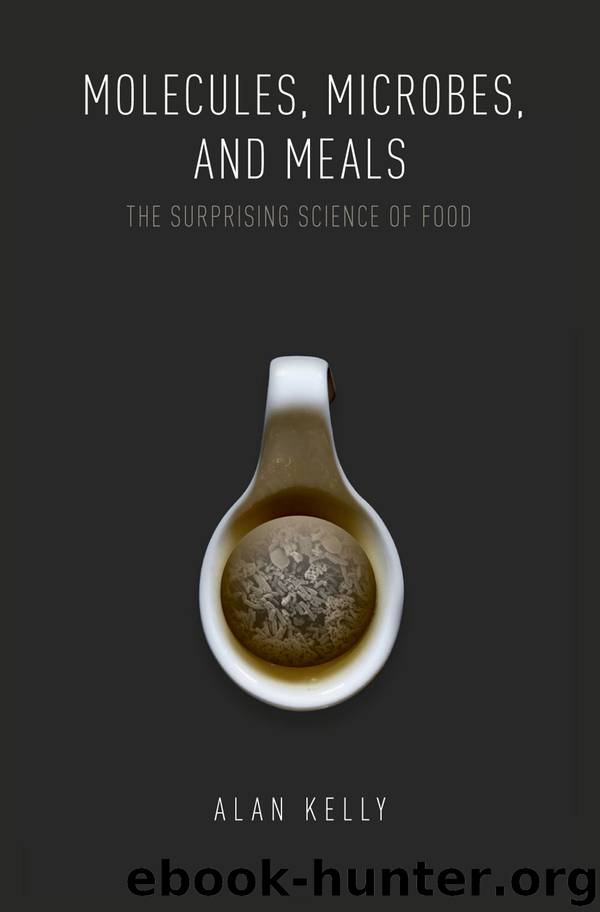Molecules, Microbes, and Meals by Alan Kelly

Author:Alan Kelly
Language: eng
Format: epub
Publisher: Oxford University Press
Published: 2019-02-26T16:00:00+00:00
What do dates on food packages mean?
One area of information provision to consumers that can be as confusing as it is critically important is the part of the label on the package which gives a date beyond which something will apparently happen to the food product therein that is not desirable.
In the European Union (EU), food packages can present either a “best-before” or “use-by” date. In the United States, the term “expiration date” might be found more commonly than the latter, but it is not legally required for such information to be provided on most food packages (the exception being infant formula), and different states have different rules for this aspect of food labeling. These dates might be specified to a day and month for shorter-life products (shelf life of days or weeks), or simply month and year for longer-shelf-life products, and in all cases refer to products being stored under conditions specified by the manufacturer (if someone keeps a chilled product at room temperature, for example, all bets are off). The difference between best-before and use-by dates is both huge and frequently misunderstood, and perhaps leads to huge amounts of wasted and unnecessarily discarded food.
As discussed throughout this book, while all food products can be susceptible to change after manufacture because of microbial, chemical, physical, or enzymatic processes, some are inherently less likely to become unsafe for consumption as a result than others.
Foods that have conditions that are favorable to the growth of pathogenic microorganisms even after processing, for example, must display in the EU a “use-by” date, to indicate the date after which the manufacturers have determined that there is a risk of harm occurring because of such growth. The product should not be eaten, cooked, or frozen after this date, even if it looks (and smells) fine. Such dates will have been determined by a number of methods, from “spiking” trials including highly controlled studies of survival and growth of the microorganism of concern to mathematical models based on previous studies of similar products. Examples of products that require a use-by date include pasteurized milk, meat, fish, and ready meals.
For some products, there is no expectation of changes during storage that would give rise to a hazardous outcome, and so the main concern might be that changes during storage would result in a less-acceptable product, for example in terms of flavor or appearance. In such cases, a “best-before” date is applied to indicate to consumers that, after that date, the manufacturer will not claim that their ideal eating experience will be delivered. A best-before date will be found on products such as canned food (where the heat treatment has eliminated all microorganisms, pathogenic or not), heat-treated fruit juice (where the highly acidic conditions will make growth of any pathogens that might have survived the heat treatment impossible), or frozen or dried food products (as these processes will essentially have prevented the growth of pathogens).
A best-before date does not indicate that the product should be discarded after that
Download
This site does not store any files on its server. We only index and link to content provided by other sites. Please contact the content providers to delete copyright contents if any and email us, we'll remove relevant links or contents immediately.
Craft Beer for the Homebrewer by Michael Agnew(18146)
Marijuana Grower's Handbook by Ed Rosenthal(3624)
Barkskins by Annie Proulx(3314)
Project Animal Farm: An Accidental Journey into the Secret World of Farming and the Truth About Our Food by Sonia Faruqi(3179)
The Plant Messiah by Carlos Magdalena(2884)
Red Famine: Stalin's War on Ukraine by Anne Applebaum(2874)
0041152001443424520 .pdf by Unknown(2787)
Organic Mushroom Farming and Mycoremediation by Tradd Cotter(2631)
In the Woods by Tana French(2535)
Beer is proof God loves us by Charles W. Bamforth(2378)
7-14 Days by Noah Waters(2362)
Reservoir 13 by Jon McGregor(2244)
Borders by unknow(2232)
Meathooked by Marta Zaraska(2222)
The Art of Making Gelato by Morgan Morano(2218)
Birds, Beasts and Relatives by Gerald Durrell(2179)
Between Two Fires by Christopher Buehlman(2174)
The 7 Habits of Highly Effective People: Powerful Lessons in Personal Change (25th Anniversary Edition) by Covey Stephen R(2141)
The Lean Farm Guide to Growing Vegetables: More In-Depth Lean Techniques for Efficient Organic Production by Ben Hartman(2099)
